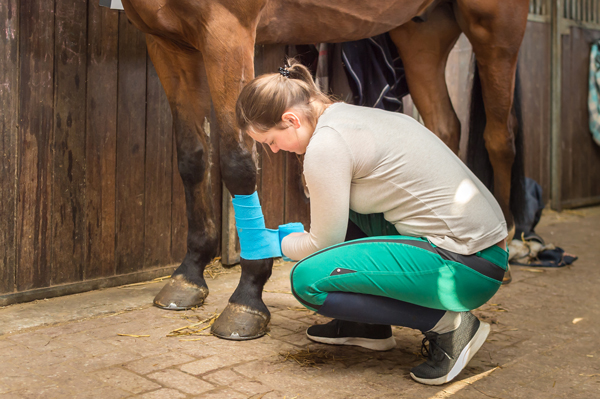
Sooner or later, it’s bound to happen. Your horse comes in with a wound that needs attention. Do you know the best first aid for your horse’s needs?
“The body has its own marvelous mechanisms for healing injured tissue,” states Mays. “Following the trauma, the body sends white blood cells to the injured site to clean up the damaged cells and fight infection. These white blood cells rid the wound of dead cells and bacteria. This expelling of non-viable cells can be seen as either a clear or slightly yellow discharge.”
The first thought at the sight of this oozing is to dry it up, however, the white blood cells need moisture to continue their healing work, explains Mays. If additional moisture is needed, an antibiotic topical ointment can be applied.
“The body also responds to the wound with inflammation,” notes Mays. “The cells that respond to the injured tissue do so to increase blood flow which facilitates clean up and repair of the wound. This extra flow of blood brings swelling, redness and heat to the injured area. Therefore, inflammation should be controlled but not suppressed.”
The body continues to remove contaminants while there is inflammation, explains Mays. As decontamination continues, cells that produce repair material move into the wound area. Then granulation tissue forms. Excessive granulation can result in “proud flesh” when the new tissue extends beyond the surface of the wound margins. Moisture does stimulate granulation and excessive moisture often results in “proud flesh” which prohibits continuation of the healing process. If the wound appears to have excessive granulation tissue, the aid of veterinary care is often needed.
“Wound treatment may include a combination of antibiotics to control infection, anti-inflammatory injections for pain management and ointments for wound medication,” notes Mays.
In treating any wound, the first step should be to clean the injured flesh, states Mays. Flushing the wound with water or saline solution will help remove dirt and bacteria from the cut. Saline solution can be made by dissolving two tablespoons of table salt in one gallon of distilled water. Wounds that are exceptionally dirty may need an antimicrobial wash which contains iodine. This wash will kill surface bacteria while cleansing the wound.
“Call your veterinarian if the wound is over a joint, involves bone/ligaments or pulls apart when your horse moves,” explains Mays. “A wound to your horse’s leg, especially near a joint where there is motion, should be referred to your veterinarian. If your horse receives a below-the-knee leg wound, it is best to seek medical assistance since leg tissue mass is limited and there can be contamination from dirt.”
Bandaging may not be necessary for some cuts and abrasions. However, leg wounds may need bandaging to reduce dirt contamination and skin motion so that healing can occur, notes Mays. A bandage keeps topical medication on the wound. Also, the light pressure of the bandage suppresses excess outgrowth of skin and promotes less scaring.
Small wounds may go undetected, cautions Mays. They may not be seen before contamination and infection occur. Since tetanus is always a threat, be sure that your horse receives a tetanus vaccination and stays current.
Horses are prone to injury. Knowing basic first aid treatments for healing their wounds will allow you to assess the situation and determine the best treatment for your horse. The right medication administered at the proper time by the proper person can facilitate the natural healing process of your horse’s body.
Further Reading
Wound Care Chart






I REALLY LIKE HOW IN DEPTH THE HEALING PROCESS WAS EXPLAINED. INFORMATIVE AND INTERESTING AT THE SAME TIME. THANKS!
Great article, really stated things in an easy to understand way! Thanks!!
i love caring for horses when they are sick or injured, i really think if you take time to help the horse get better you will develope a better bond with the horse your helping.and also i love putting on different leg bandages ,or put on healing ointments! i just really love mothering horses! and these are great tips!
I loved this article. I didn’t know that moisture contributes to granulation. Got to keep that in mind with my own wounds!
Be grateful of your horse has no injuries last year our horse air mailed our barb wired fence and had to get stitches she was carrying her foal mags and didn’t lose it my babe was born April 24 2012 and silvers scars from jumping have faded so we have to redo it the fence. Mags is very fast silver turned out much better but when silver jumped I was riding and my horse freaked he took off and I pulled him up and just screamed…… I thought she was dead! But mags or SIlver Magna should I say just got over pneumonia and now you are reading about the 2015 kentuckey derby winner
YouTube video with vet explaining different types of wound and how horses heal. There are demonstrations of how to dress and bandage wounds at different locations on the horse – foreleg, hind leg, on the hock, above the hock and the foot.
http://horse-clips.co.uk/2013/11/video-wound-management/